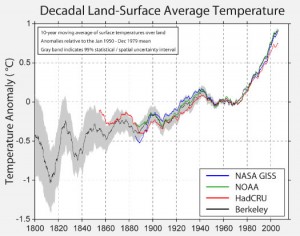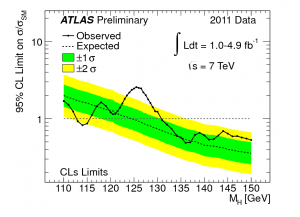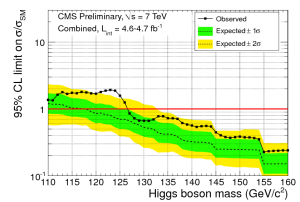There is too much interesting science that happens in a single year. No one person can capture it in a single article. I choose to focus on the things that align with my own personal interests, and provide information about them so you can learn more. They are in no specific order, except that I put the physics one last because it seems a little too contrived to stick it first.
The Berkeley Earth Project Climate Change Results

A much-anticipated result appeared this year from the Berkeley Earth Project [1], headed by Richard Muller of Berkley. A climate skeptic and favorite of the climate denialist movement, Muller’s group released their preliminary findings in October. At the heart of their approach was an evaluation of the quality of land temperature stations and the accounting of prominent weather effects such as the Atlantic Multidecadal Oscillation (AMO [2]) and the El Nino Southern Oscillation (ENSO [3]). AMO, they conclude, is the primary cause of temperature variability on short (decadal) timescales. If you’ve recently read headlines from climate denier news sites and talking heads claiming that the Berkeley project confirms the “cooling” in the last 10 years, you now understand why this is a total mis-reading of the data from the project; AMO is the cause of recent relative cooling, but we can expect that to be following be significant warming as the oscillation swings again and adds up with the overall global temperature increase from long-term warming.
The plot I show here makes it into my favorite plot of the year category. The average land-surface temperature change (averaged over a 10-year moving window) shows the accelerating increase in global land temperature since 1800. The new analysis reveals the warming has been occurring for longer than previously expected. The increase in temperature beginning slowly in the first half of the 1800s would certainly coincide with the increasing use of coal to heat homes, leading up to the industrial revolution that occurred mid- and late-century.
Since we know from independent means (e.g. radioisotopic analysis) that the new CO2 in the atmosphere in at least the last century has been put there from deep, sequestered sources (depleted in C13 thanks to shielding from cosmic ray radiation) only accessed by humans, the conclusion is more irrefutable than ever: humans have been pumping a greenhouse gas into the atmosphere, that amplifies the effects of more severe greenhouse gases like methane and water, and have initiated and sustained an incredible period of accelerated warming.
Muller made another significant impact through all of this. He has helped to show the plain difference between a skeptic and a denier. A real skeptic is willing to withhold judgement until evaluating the data, and does so using the scientific method. A denier will never change their mind even in the face of evidence (scientific or otherwise) to the contrary. It goes a long way to making the people who still refute the existence of global climate disruption look like the deniers they actually are. Perhaps that, more than anything, is the greatest benefit of this work in the public eye: to separate the skeptics from the deniers, and expose the deniers.
The four papers produced by this project in 2011 have been submitted for publication to Journal of Geophysical Research (Atmospheres) (http://www.agu.org/journals/jd/).
Anti-Science Legislation in New Hampshire
While overall 2011 was a fairly quiet year when it came to legal assaults on the teaching of science, such as evolution, 2012 may start off with a big bang: a few New Hampshire state legislators have entered bills for the next session, both of which twist the definition of scientific terms and science teaching (e.g. conflating the popular notion of a “theory” – an untested idea or speculation, which in science is more akin to an “untested hypothesis” – with that of a “scientific theory,” which is based on one or more hypotheses, incorporates and explains facts, and leads to predictions, future tests, and previously unobtained knowledge).
One of the bills, filed by Jerry Bergevin (R-District 17), would insert the following into the list of duties of the State Board of Education,
New Paragraph; Duties of the State Board of Education. Amend RSA 186:11 by inserting after paragraph XXXVI the following new paragraph:
XXXVII. Theory of Evolution. Require evolution to be taught in the public schools of this state as a theory, including the theorists’ political and ideological viewpoints and their position on the concept of atheism. [5]
It conflates science with the scientist, as if the political leanings or personal religious beliefs of the researcher have everything to do with whether or not they can do science. Why aren’t historians, with history being such a fluid and interpretive field, required to do this? Why only scientists? The problem is that scientific work challenges long-held and evidence-free notions of the natural world and that makes people uncomfortable. Yet, science is also the same system of knowing that has advanced human knowledge and achievement beyond any other system of knowing. To conflate science with a social construct or endeavor, or slave only to the personal beliefs of the practitioner, is to change the very definition of this human endeavor.
The other bill, filed by Gary Hopper (R-District 7) and Burt Hills (R-District 7), also amends the duties of the State Board of Education,
1 New Paragraph; Duties of the State Board of Education. Amend RSA 186:11 by inserting after paragraph XXXVI the following new paragraph:
XXXVII. Scientific Inquiry. Require science teachers to instruct pupils that proper scientific inquire [sic] results from not committing to any one theory or hypothesis, no matter how firmly it appears to be established, and that scientific and technological innovations based on new evidence can challenge accepted scientific theories or modes. [6]
First of all, I admire the poor grammar of this bill (” . . . instruct pupils that proper scientific inquire results . . . “). Second, I admire the complete lack of understanding of science that is entered into the list of SBOE duties. It is the duty of the scientist to adhere to a theory if that theory explains facts, makes predictions, and allows for further tests on the validity of the theory. That’s how progress is made. You can’t entertain every crazy idea. The scientist always walks a fine line, open to inquiry while applying established theory, fact, and law. But to say that the duty of a scientist is to always be cynical about the verity of established theory, fact, and law makes unnecessary work for the scientist and misleads students about the nature of science.
All of this, of course, is just a means by which to weaken science standards so that, eventually, pseudoscience like astrology, intelligent design, chiropractic, homeopathy, etc. can be taught alongside astronomy and physics, evolution, medicine, and chemistry. It will be interesting to see how New Hampshire’s legislators handle this. Clearly, 2012 will be a year of renewed assault on science in the United States.
The End of the Tevatron at Fermilab
Technically, this isn’t a “favorite” – rather, this is notable and important, though sad as a marker in American science history. In October, the last operating particle physics collider in the United States ceased operation [7]. This ends a long era in the U.S. where there has always been a frontier-level particle collider experiment. The Tevatron had many fundamental measurements and discoveries in its long history, not the least of which was the discovery of the top quark.
Let’s raise a glass to this chapter of American science history. Now that there are no more operating frontier collider experiments in the U.S., and basic science funding has a constantly uncertain future, it is hard to say how the next chapter will look.
The Large Hadron Collider Leaves Few Hiding Spots for the Higgs Boson

At the end of 2011, the ATLAS and CMS [8] experiments delivered very public twin seminars showcasing their first results using all of the available LHC data in the search for the Higgs Boson. The Higgs boson is the physical manifestation of the Higgs field, a phenomenon that fills spacetime and causes interactions with other particles that give them the apparent inertial masses that we observe. For instance, the electron would actually be a massless particle forever moving at the speed of light if not for the interaction with the Higgs field. At least, that was the prevailing hypothesis for how mass arises and is a central feature of the most successful theory of nature every arrived at by our species: the Standard Model of Particle Physics.

The Higgs boson had never been observed. All indirect evidence for its existence, of which there is plenty, pointed to it having a mass somewhere between about 70-150 GeV (that is, about 70-150 times the proton mass). ATLAS and CMS reported that they have seen an intriguing excess of Higgs-like events with a mass collecting most prominently around 126 GeV. More importantly, both experiments have ruled out nearly all other possible masses for the Higgs up to 500-600 GeV. This leaves little place left for the Higgs to hide, and perhaps even an intriguing mass at which to concentrate the search. 2012 will be a VERY exciting year at the LHC.
[1] http://berkeleyearth.org/analysis/
[2] http://en.wikipedia.org/wiki/Atlantic_multidecadal_oscillation
[3] http://en.wikipedia.org/wiki/El_Ni%C3%B1o-Southern_Oscillation
[4] http://steve.cooleysekula.net/blog/2011/08/21/the-greenhouse-effect-part-3-gas-amplifier/
[5] http://www.gencourt.state.nh.us/legislation/2012/HB1148.html
[6] http://www.gencourt.state.nh.us/legislation/2012/HB1457.html
[7] http://www.fnal.gov/pub/tevatron/milestones/interactive-timeline.html
[8] http://www.atlas.ch/news/2011/status-report-dec-2011.html and http://cms.web.cern.ch/news/cms-search-standard-model-higgs-boson-lhc-data-2010-and-2011

